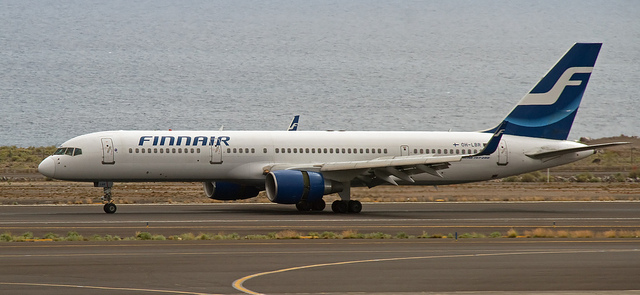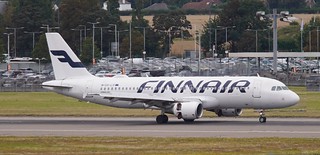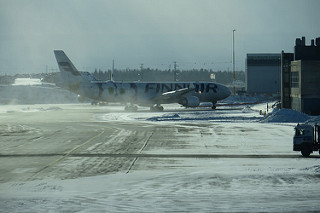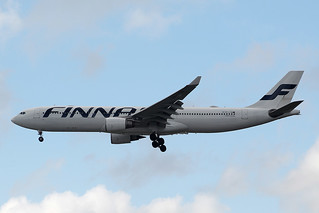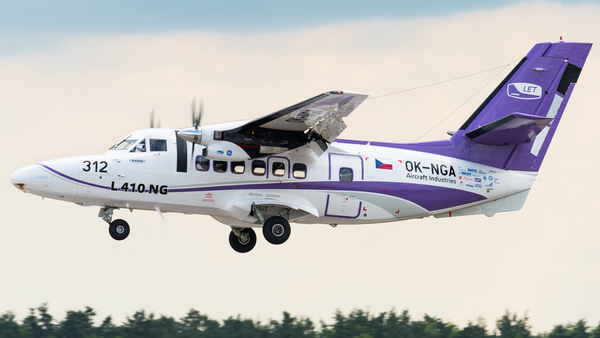Finnair B752 and Thomas Cook B752 near Tenerife on Nov 20th 2011, near collision
Last Update: April 19, 2013 / 13:56:58 GMT/Zulu time
Incident Facts
Date of incident
Nov 20, 2011
Classification
Report
Cause
Near collision
Airline
Finnair
Flight number
OY-1601
Departure
Helsinki, Finland
Destination
Tenerife Sur Sofia Reina, Spain
Aircraft Registration
OH-LBR
Aircraft Type
Boeing 757-200
ICAO Type Designator
B752
A Thomas Cook Boeing 757-200, registration G-TCBA performing flight MT-2456 from Manchester,EN (UK) to Tenerife Sur Sofia Reina,CI (Spain) with 217 passengers and 6 crew, was enroute at FL370 nearing Tenerife and the top of descent also set to track ORTIS3G arrival route slightly in trail of OH-LBR, both aircraft were in contact with Canaries Center NNW Sector.
When OH-LBR requested descent, the controller cleared the aircraft direct to waypoint ODULA and to descend to FL250. At the same time the radar label of G-TCBA split now showing targets at FL405 and FL370, both with the same squawk. About a minute later the controller instructed G-TCBA to descend to FL370, to which the crew replied they were already at FL370 prompting the controller to instruct the aircraft turn right 30 degrees. Immediately afterwards OH-LBR inquired to verify their clearance to FL250 reporting they had received a TCAS advisory followed by a report the conflict had been cleared a couple of seconds later.
Both aircraft continued for safe landings on Tenerife.
Spain's CIAIAC released their final report into the serious incident reporting the minimum separation between the aircraft had reduced to 0 feet vertical and between 0.7 and 0.9nm horizontal concluding the probable cause of the serious incident was:
This incident is regarded as having been caused by the clearance given by the controller to aircraft FIN1601 to descend from flight level 390 to 250, crossing through the flight level being occupied by aircraft TCX13CS, FL370, resulting in a violation of the minimum radar separation distance prescribed.
The following are considered to have contributed to the incident:
- A possible garbling problem that made it possible for the label on the radar display for aircraft TCX13CS to show that it was flying at flight level 405.
- The controllerÂ’s failure to detect the fault that existed with the labels.
- The improper response by the crew of aircraft FIN1601 to the climb advisory issued by its TCAS.
The CIAIAC reported that OH-LBR was descending at 3300 fpm after being cleared down when TCAS activated at a separation of 700 feet vertical and 1.3nm horizontal with a resolution advisory "Adjust vertical speed" requiring the aircraft to maintain a vertical speed of 0 fpm, G-TCBA received a traffic advisory. A second later the Finnair TCAS instructed the crew to "Climb! Climb!" (requiring 1500 fpm climb), the Thomas Cook TCAS issued a resolution advisory "Descend! Descend!" (requiring a 1500 fpm descent). Six seconds later G-TCBA began to descend, while OH-LBR was 259 feet above descending at 4200fpm. Another six seconds later OH-LBR had descended through the altitude of G-TCBA reaching a descent rate of 4400 fpm, OH-LBR's TCAS now reverted to "Maintain vertical speed" and G-TCBA's TCAS reverted to "Climb! Climb now!". Another 6 seconds later both TCAS systems announced "Clear of conflict".
CIAIAC analysed that the controller believed OH-LBR was below G-TCBA shown at FL405 probably due to the split/garbled target when he cleared OH-LBR to descend to FL250. However, the controller did not only not detect the split target display, he also missed the opportunity to detect the conflict and his false assessment of the situation when G-TCBA requested descent. In addition he also missed the discrepancy between the flight strip indicating FL370 and the radar display showing FL405.
As result the CIAIAC stated: "The facts exposed in the above paragraphs indicate that the controller did not detect the faults in the system, probably due to his insufficient knowledge of the system and of the means available for detecting them. As a result, the investigation has concluded that the level of knowledge controllers have of this matter should be assessed and, if so warranted by the findings, specific training should be added as part of their continuous training program. A safety recommendation is issued in this regard."
The CIAIAC analysed that the crew of OH-LBR/Y-1601 reacted improperly to the TCAS resolution advisories when they continued to descend instead of arresting the descent and start climbing as instructed by TCAS. The CIAIAC continued: "Studies of close calls involving aircraft receiving TCAS advisories have revealed that the most unfavorable situation occurs when one crew responds as indicated by TCAS and the other in the opposite direction to that instructed."
The CIAIAC reported with respect to the split target, that a technical incident was filed by AENA that seemed to match the characteristics of non-Mode-S radars when the oblique distances between aircraft and radar are very similiar: "Given this similarity in the distance, an overlap occurred in the reply received by the radars from the aircraft, resulting in new tracks appearing on the screen and in the label for aircraft TCX13CS splitting from the corresponding aircraft symbol."
Incident Facts
Date of incident
Nov 20, 2011
Classification
Report
Cause
Near collision
Airline
Finnair
Flight number
OY-1601
Departure
Helsinki, Finland
Destination
Tenerife Sur Sofia Reina, Spain
Aircraft Registration
OH-LBR
Aircraft Type
Boeing 757-200
ICAO Type Designator
B752
This article is published under license from Avherald.com. © of text by Avherald.com.
Article source
You can read 2 more free articles without a subscription.
Subscribe now and continue reading without any limits!
Read unlimited articles and receive our daily update briefing. Gain better insights into what is happening in commercial aviation safety.
Send tip
Support AeroInside by sending a small tip amount.
Related articles
Finnair B752 near Nantes on Apr 8th 2012, engine issue
A Finnair Boeing 757-200, registration OH-LBR performing flight AY-1541 from Helsinki (Finland) to Fuerteventura,CI (Spain), was enroute at FL370…
Finnair A320 at Vienna on Oct 7th 2025, hydraulic leak and smoke
A Finnair Airbus A320-200, registration OH-LXD performing flight AY-1471 from Helsinki (Finland) to Vienna (Austria), landed on Vienna's runway 34,…
Finnair A320 at Berlin on Mar 31st 2025, engine fire indication
A Finnair Airbus A320-200, registration OH-LXI performing flight AY-1434 from Berlin (Germany) to Helsinki (Finland) with 160 people on board, was…
Finnair A320 at Helsinki on Nov 21st 2024, lightning strike
A Finnair Airbus A320-200, registration OH-LXF performing flight AY-1255 from Helsinki (Finland) to Budapest (Hungary), was climbing through about…
Finnair A333 at Helsinki on Aug 3rd 2024, odour on board
A Finnair Airbus A330-300, registration OH-LTO performing flight AY-15 from Helsinki (Finland) to New York JFK,NY (USA), was climbing out of…
Finnair A333 over Canada on Apr 28th 2024, engine shut down in flight
A Finnair Airbus A330-300, registration OH-LTM performing flight AY-10 (dep Apr 27th) from Chicago O'Hare,IL (USA) to Helsinki (Finland) with 194…
Newest articles
Van L410 at Mestia on Jul 13th 2025, unintentional engine shut down on landing
A Van Air Europe Let L-410, registration OK-VAA performing flight V9-10 from Tbilisi to Mestia (Georgia), had landed on Mestia's runway and was…
Jetblue A320 near Tampa on Oct 30th 2025, inflight upset causes injuries
A Jetblue Airbus A320-200, registration N605JB performing flight B6-1230 from Cancun (Mexico) to Newark,NJ (USA), was enroute at FL350 about 70nm…
Subscribe today
Are you researching aviation incidents? Get access to AeroInside Insights, unlimited read access and receive the daily newsletter.
Pick your plan and subscribePartner

ELITE Simulation Solutions is a leading global provider of Flight Simulation Training Devices, IFR training software as well as flight controls and related services. Find out more.
SafetyScan Pro provides streamlined access to thousands of aviation accident reports. Tailored for your safety management efforts. Book your demo today
AeroInside Blog
Popular aircraft
Airbus A320Boeing 737-800
Boeing 737-800 MAX
Popular airlines
American AirlinesUnited
Delta
Air Canada
Lufthansa
British Airways


